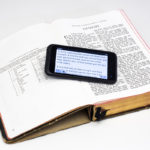- The Explore the Bible lesson for Dec. 13 focuses on Luke 1:26-38.
“Silent night, holy night. All is calm, all is bright. Round yon virgin mother and child!” At the heart of our Christmas traditions is the singing of some good Christmas songs. And at the heart of this favorite Christmas song (Silent Night) is its introductory exclamation about one of the most important doctrines of our Christian faith, the virgin birth of Jesus.
Theologian Millard Erickson states “Next to the resurrection, the most debated and controversial event of Jesus’s life is the virgin birth, the means through which Christ took on human form.” Among theologians, this doctrine has been discussed and debated for years, going back to the late 19th and early 20th centuries. But the idea of the virgin birth isn’t just questioned in academia.
What do people “at large” say about the virgin birth? A 2017 Pew Research Center survey found that while 66 percent of Americans believe Jesus was born to a virgin, that number is down from 73 percent in 2014. It would be understandable for nonbelievers to wrestle with doubts about the Christmas story in the Bible, but the Pew research indicates some growing doubts about its facts even among Christian demographics. The percent of white mainline Protestants who believe the virgin birth is down from 83 percent to 71 percent in just these three years. Among religious “nones,” those who don’t identify religiously with any group or belief system, the belief in the virgin birth has declined from 30 percent in 2014 to 17 percent in 2017. And perhaps most alarmingly, among young adults, ages 18-24, that percentage has dropped from 70 percent in 2014 to only 54 percent three years later. The virgin birth certainly seems to be diminishing in its significance and relevance to many Americans.
Two times is plenty
So, what does the Bible actually say about the virgin birth, and why would we say that this doctrine is so important, if not essential, to our faith? The fact is there are only two explicit biblical references to the virgin birth of Jesus—Matthew 1:18-25 and Luke 1:26-38 (the focus of our study this week).
Additionally, the famous Messianic prophecy of Isaiah 7:14 proclaims, “Therefore the Lord himself will give you a sign: The virgin will conceive and give birth to a son, and will call him Immanuel.” Some translations of this Isaiah passage state that it’s only a “young woman” who will conceive. While that is certainly one possible translation of the Hebrew word that is used, it’s noteworthy that when the Hebrew Scriptures were translated into Greek by a panel of Hebrew scholars and Jewish rabbis some 200 years before Jesus’s birth (The Septuagint), they chose to use the specific Greek word for virgin, not young woman. The fact that Jewish scholars, of all people, who had no inherent reason to believe in a “virgin birth,” would translate the word this way gives evidence that “virgin” was, most likely, the intended meaning of the word.
The biblical references to the virgin birth are not plentiful, but as Erickson concludes: “That the Bible affirms the virgin birth not once, but twice, however, is sufficient proof. Since we believe the Bible is inspired and authoritative, Matthew 1 and Luke 1 convince us that the virgin birth is fact.”
A lynchpin doctrine of the Christian faith
And what about the essential nature of the virgin birth as a “lynchpin doctrine” of our faith? Carl F.H. Henry, who’s been called the dean of evangelical theologians, argued the virgin birth is “the essential, historical indication of the Incarnation, bearing not only an analogy to the divine and human natures of the Incarnate, but also bringing out the nature, purpose, and bearing of this work of God to salvation.” Erickson adds, “If we do not hold to the virgin birth despite the fact that the Bible asserts it, then we have compromised the authority of the Bible and there is in principle no reason why we should hold to its other teachings. Thus, rejecting the virgin birth has implications reaching far beyond the doctrine itself.” Albert Mohler, president of the Southern Baptist Theological Seminary, posits: “This much we know: All those who find salvation will be saved by the atoning work of Jesus the Christ, the virgin-born Savior. Anything less than this is just not Christianity, whatever it may call itself. A true Christian will not deny the Virgin Birth.”
So, let’s all sing some good Christmas songs this Christmas. And in doing so, let’s unashamedly sing our doctrine of that special “round yon virgin” Mary and the miraculous virgin birth of our amazing Savior and wonderful Lord.
Miraculous entrance! Miraculous exit!
I can’t help closing out this discourse on the beginning of the Christmas story, and its vital connection with the miraculous virgin birth of the Christ of Christmas, without also including “the rest of the story.” The “miraculous beginning” of the Christmas story just isn’t complete without fast forwarding some 33 years to the “miraculous climax” of the story. Just as an angel announced to little Mary the miracle that she would give birth to the Savior, an angel announced another miracle to two other “Marys” at the “exited” tomb of Jesus, “Do not be afraid, for I know that you are looking for Jesus, who was crucified. He is not here; he has risen, just as he said.” (Matthew 28:5-6).
Sign up for our weekly edition and get all our headlines in your inbox on Thursdays
A miracle birth … a miracle resurrection. From beginning to end, Jesus truly had “Miraculous Entrance! Miraculous Exit!” Let’s all “sing out” that miracle story this Christmas!
Jim Lemons is professor of theological studies and leadership at Dallas Baptist University. He is a senior adult Sunday school teacher at Park Cities Baptist Church in Dallas.














We seek to connect God’s story and God’s people around the world. To learn more about God’s story, click here.
Send comments and feedback to Eric Black, our editor. For comments to be published, please specify “letter to the editor.” Maximum length for publication is 300 words.